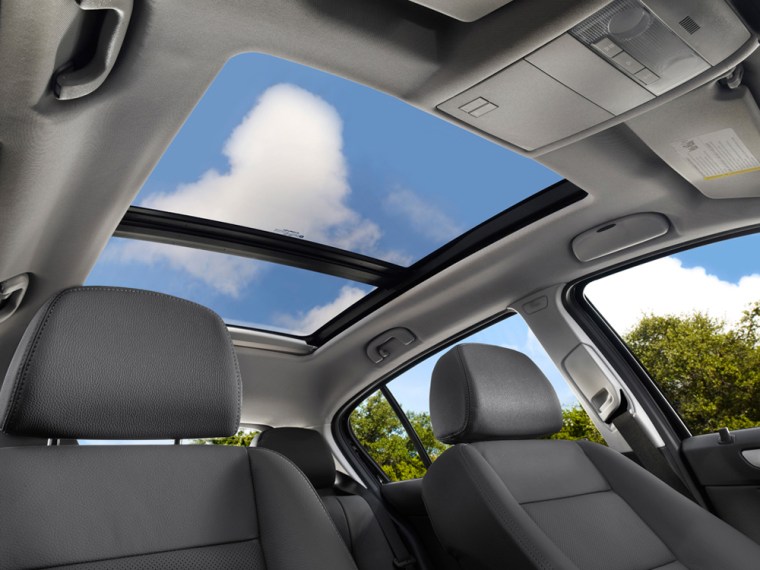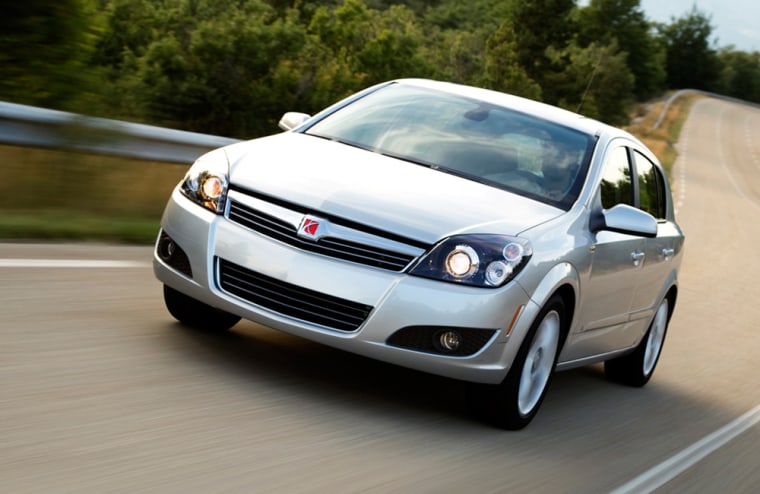In search of the much sought after soul of European cars — vehicles that are quick enough to be fun, but frugal enough to be practical — American carmakers have promiscuously slapped the label “Euro” on whatever cars they saw fit.
Now Saturn is bringing unadulterated European products directly to U.S. customers. The Saturn Astra, a European model developed and sold by Opel, part of General Motors’ GM Europe brand, is the best-selling car there. And with it Saturn hopes to tap into a group of under-served Europhiles who appreciate European models for their traditional virtues.
In the Astra, Saturn has delivered that experience faithfully. It’s a superb little car that will please both Speed Racers and Joe Commuters courtesy of its artful balance of efficiency with excitement and precision with comfort. Firm, well-controlled suspension and well-executed electric power steering allow the car to go exactly where the driver intends, while providing continuous status reports on progress along the way.
The little Saturn accomplishes this, however, without the punishing ride characteristic of many sporty cars and without the bouncy ride so common among small cars. GM’s Opel engineers in Russelsheim, Germany have tuned the springs, shock absorbers and anti-sway bars perfectly, an accomplishment that is invisible on a spec sheet but which is readily apparent to the driver. This is in contrast to those cars that boast impressive technical credentials, but whose engineers failed to sweat the details of exploiting those credentials to maximum benefit.
The Astra has a lightly regarded torsion-beam rear axle rather than the technically superior independent rear suspension, and electric power steering in place of the usually preferred hydraulic power assist, but it suffers none for the selection of these budget parts.
Other controls — such as the clutch, brakes and shifter — are also well-developed so that they are light and easy to use, while still giving the driver the feedback needed to drive the car confidently. The three-door should prove a formidable competitor to premium hatchbacks such as the Volvo C30, which enjoys sporty styling, but whose clutch and shifter seem designed to irritate, rather than excite, enthusiasts.

Using cheaper hardware like torsion-beam suspension leaves money for features like the Astra’s standard electronic stability control system, a critical safety feature which is unavailable at any price on the Mazda3, a car that has been near to enthusiasts’ hearts since its debut.
Saturn/Opel also saved money on the transmission. The standard five-speed manual gearbox is typical fare for the segment, but the four-speed automatic is a little retro. Before working themselves into a bad mood over this detail, critics would do well to consider that the sainted and all-new-for-2008 Toyota Corolla also has a four-speed automatic transmission and a torsion beam rear axle.
But Toyota failed to tune its pedestrian hardware as effectively, and the Corolla exhibits correspondingly pedestrian results. The Astra’s transmission is perfectly programmed, shifting smoothly and surely, without hunting for the right gear. Rare is the driver who would notice the absence of an additional gear, though its slightly lower fuel economy rating than the five-speed manual may be the penalty.
The Saturn also employs a nifty feature in its automatic transmission that takes advantage of its ability to change gears on its own to help disguise the inherent coarseness of four-cylinder engines at idle. When the Astra is stopped and the transmission is in Drive, the car automatically switches to neutral, so the engine doesn’t strain to move the car forward in gear.
This means that the engine idles more smoothly, and it saves a little gas since it isn’t working itself into a lather when waiting for traffic lights to change. The engine is so smooth at idle that I wondered at first if the car was equipped with an automatic stop/start capability.
Why doesn’t every new car do this?
This European perspective also means that electric seat heaters are available as a standalone option for only $250, without the requirement of leather seats or other luxury features. Europeans also like sunroofs, and the Astra five-door has a huge one. Its panoramic power sunroof costs $1,000 and surely adds weight while intruding on headroom, but its effect on the cabin is glorious — at least in winter. In summer, the shade might well be drawn much of the time.
The Astra includes comfort features that are perhaps unexpected in a compact car, such as seats that are actually comfortable and supportive, with an adjustable lumbar support for the front seats. The back seat is sufficiently capacious that two adults can ride with ample leg and elbow room, but three-abreast seating is best reserved for children — ones who can tolerate being in close proximity. The cargo space under the rear hatch is surprisingly large, with space for even large, bulky luggage.
Unfortunately, there are reasons that GM engineers models specifically for the U.S. market. The Astra’s color palette is distinctly European and both of the test cars were finished in a Black Sapphire paint that spoke of low sodden skies over London or Frankfurt. In addition to the array of undertaker’s shades, the Astra is available in white or red, which are bright, but can be polarizing to customers. The Charcoal interior was similarly Stygian, but the company has a tan Cashmere cabin hue in the works that will be available this spring.
Saturn has grafted GM’s excellent OnStar telematics system onto the Astra by installing a rearview mirror with the necessary hardware inside, but nowhere on the option list is GM’s popular cold-weather remote start feature. Also missing is XM Satellite radio, another GM-backed technology, although owners can add it themselves. Instead, there’s an inscrutable cut-rate iDrive single-knob controller that’s likely to irritate American drivers.
The last, and most annoying, example of apparent cultural differences is the automatic door lock system on the Astra. While GM’s domestic models let drivers easily adjust the various electronic systems (automatic door locks and alarm settings), Astra owners are stuck with nonadjustable factory settings.
Another annoyance is the absence of a temperature gauge. On a car without automatic climate control, you need to know when the engine has warmed up so you can turn on the heat, but the Astra makes the driver just guess that it must be about time.
On balance, the Astra’s European flavor more than offsets its personality quirks. Both enthusiasts and commuters are sure to find the Astra a winning combination of excitement and efficiency that puts it at the top of the small car list, even if there is nary a “Euro” badge to be seen.
